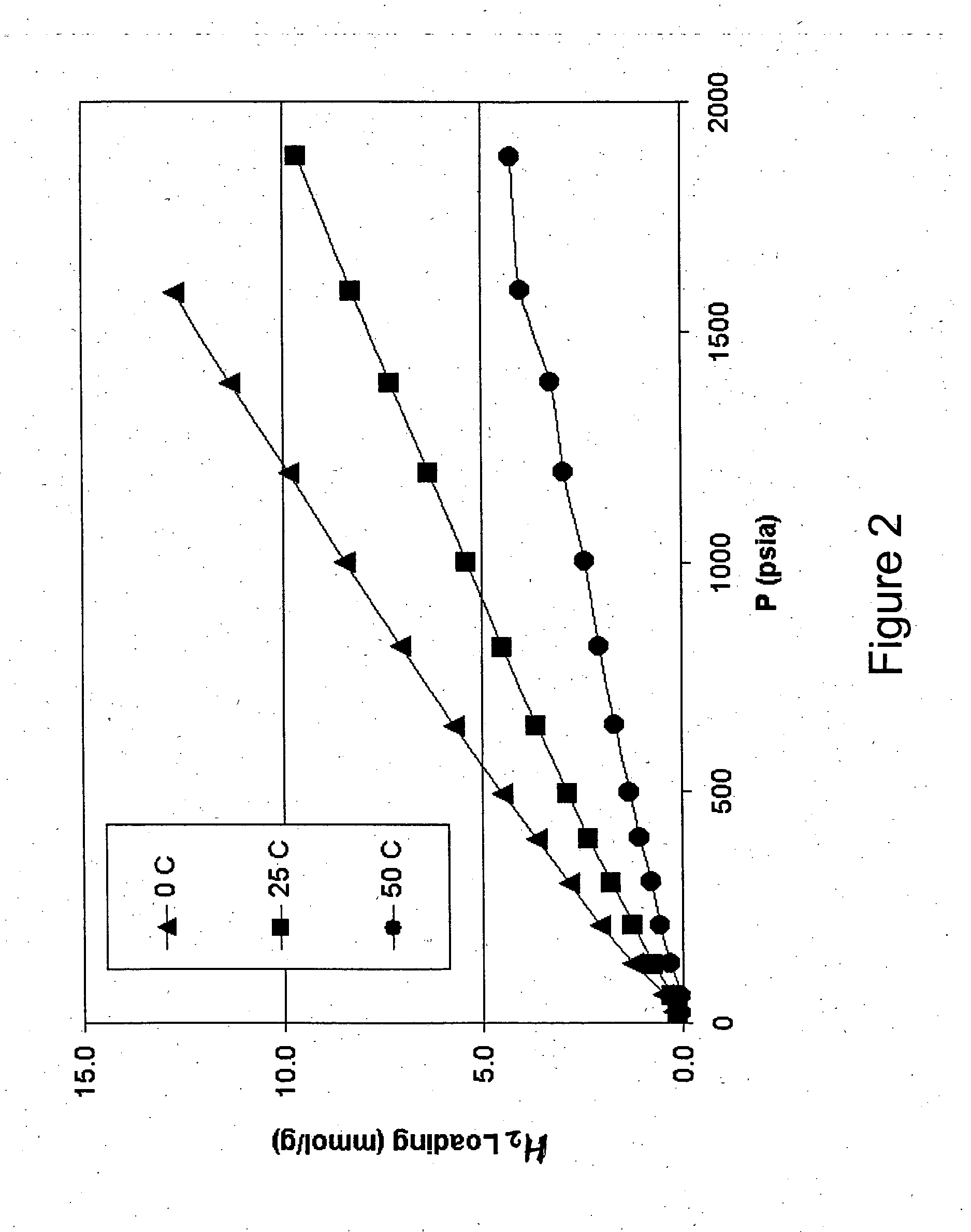Hydrogen storage utilizing carbon nanotube materials
a carbon nanotube and carbon nanotube technology, applied in the field of hydrogen storage utilizing carbon nanotube materials, can solve the problems of unfavorable thermodynamic properties, significant higher cost of delivered gas, and poor gravimetric hsub>2 /sub>capacity,
- Summary
- Abstract
- Description
- Claims
- Application Information
AI Technical Summary
Benefits of technology
Problems solved by technology
Method used
Image
Examples
example 1
Hydrogen Adsorption Isotherms and Derived Heats of Adsorption for Small-Diameter, Low-Aspect-Ratio Carbon Nanotube Array Materials
[0065] A sample of as-produced singlewalled carbon nanotubes (SWNT) was obtained from Carbon Nanotechnologies Inc. Thermogravimetric oxidation analysis determined that the as-produced SWNT contained ca. 28% (wt.) iron metal catalyst from the production process. The iron metal content was reduced to ca. 2% (wt.) using a modification of a published purification process (I. W. Chiang et al, J. Phys. Chem. B., 2001, 105, 8297). The purified SWNT material was subjected to a mechanical milling process that segments the SWNT into shorter lengths, using a process described in the literature by J. Chen et al (J. Am. Chem. Soc. 2001). Atomic force microscopy and laser light scattering data show the average SWNT length is 0.260 μm after milling. Raman spectroscopy analysis shows the distribution of SWNT diameters (Table 1), which are unaffected by the milling proce...
example 2
Hydrogen Adsorption Isotherms and Derived Heats of Adsorption for Small-Diameter, High-Aspect-Ratio Carbon Nanotubes
[0066] A sample of as-produced singlewalled carbon nanotubes (SWNT) was obtained from Carbon Nanotechnologies Inc. Thermogravimetric oxidation analysis determined that the as-produced SWNT contained ca. 28% (wt.) iron metal catalyst from the production process. The iron metal content was reduced to ca. 2% (wt.) using the same process used in Example 1. A mild oxidation of the purified SWNT sample was accomplished by heating the sample in flowing dry air at 300° C. for 2 hours. Atomic force microscopy and laser light scattering data show the average SWNT length is 6.7 μm. Raman spectroscopy analysis was used to determine the distribution of SWNT diameters (Table 1). This material was degassed in a quartz cell at 873 K until a vacuum of 10−4 torr was achieved. The material was transferred under a purified argon atmosphere in a glovebox to a metal cell for adsorption ana...
example 3
Constant-NVT Molecular Dynamics Simulations of SWNT Arrays and Hydrogen
[0067] Molecular dynamic (MD) simulations of hydrogen adsorption and storage in SWNT were performed using a model where the number of atoms (N), the volume (V) and the temperature (T) of the system are kept constant. In these calculations (as expressed by Equation 2), the interactions between H and C atoms for exohedral H2 adsorption were treated differently than H—C interactions for endohedral H2 adsorption thus accounting for the curvature effect which was ignored in prior such analyses. The MD simulations were conducted with a constant-NVT canonical ensemble using the Nose thermostat for temperature control. For a given SWNT, a rectangular box imposed with the periodic boundary condition containing 1×2×10 primitive cells of the SWNT was used in the simulation for 100 picoseconds (ps). All simulations were done using the Verlet algorithm with a time step of 1 fentosecond, at room temperature. Long range intera...
PUM
| Property | Measurement | Unit |
|---|---|---|
| length | aaaaa | aaaaa |
| length | aaaaa | aaaaa |
| average length | aaaaa | aaaaa |
Abstract
Description
Claims
Application Information
 Login to View More
Login to View More - R&D
- Intellectual Property
- Life Sciences
- Materials
- Tech Scout
- Unparalleled Data Quality
- Higher Quality Content
- 60% Fewer Hallucinations
Browse by: Latest US Patents, China's latest patents, Technical Efficacy Thesaurus, Application Domain, Technology Topic, Popular Technical Reports.
© 2025 PatSnap. All rights reserved.Legal|Privacy policy|Modern Slavery Act Transparency Statement|Sitemap|About US| Contact US: help@patsnap.com



